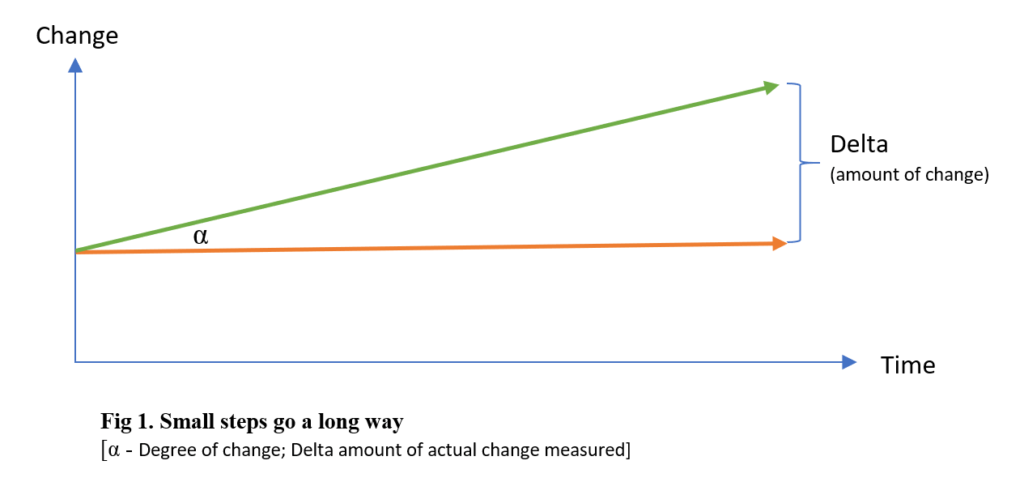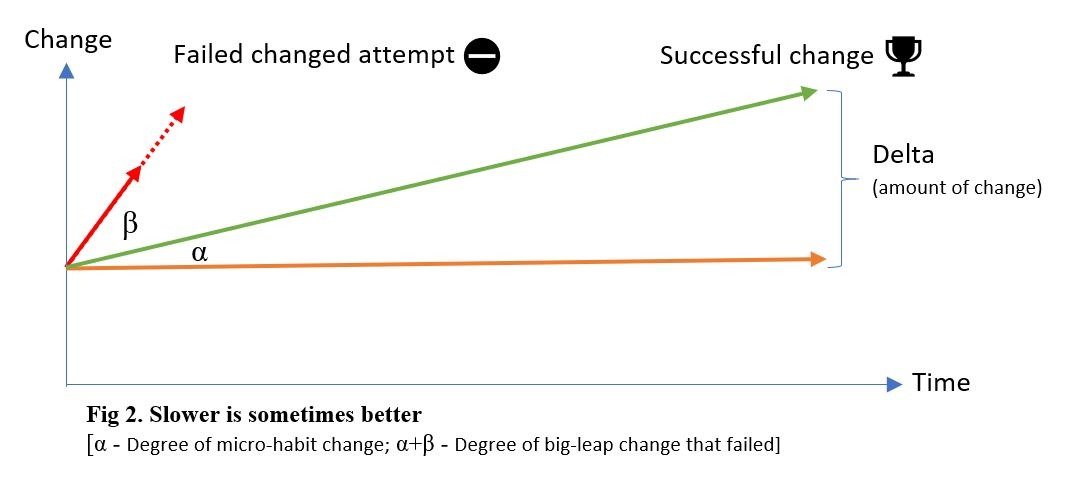
This article discusses personal, team and organizational transformation; why it is so difficult to change and how to use the three basic rules of change to find the path of least resistance
Ok, I am just going to come out and say it: The fundamental truth is that changing ourselves is very hard, and resistance is futile. Well, kind of…
We fail to change ourselves all the time. We try to eat healthier, drink more water, sleep eight hours a night, keep a balanced life, be or become loving parents and spouses, be excellent and dedicated workers, be more confident, satisfied, and successful. Yet, often we don’t succeed.
This usually happens because people are not following the three basic rules of change.
However, before we discuss the rules, let’s look at how most people try to change.
Most people’s attempts to change are, at best naïve. New Year’s resolutions are a perfect example of this approach.
At the end of the year, you look back at your life and make up your mind that from this day onwards, you will eat healthier, exercise more, lose weight, save more money, quit smoking and work fewer hours.
Yet, research clearly shows that after a week, only 75% will maintain their commitment; after a month, only 64% will still be going to that GYM or eating healthier [1], and at the end of the year out of 77% of people who were very confident or somewhat confident they would keep their resolution, only 7% report sticking to all their resolutions [2].
Although research does show that it is better to commit to New Year resolutions than to not make any resolutions—as the mere act of committing improves the chances of actually sticking to those resolutions [1]—the success rate of these commitments is very low and get even lower as we grow older.
When discussing team and organizational transformations, the statistics are not significantly different. Most researchers (although not all [4]) claim that the success rate of breakthrough transformations in organizations is between 30-38% [5].
Following these grim statistics, is it clear that we need to find a different path, a path that is much more in-line with our inherent nature as human beings.
Enter the Three Basic Rules of Change.
Rule #1: Change patterns, not people
It is (nearly) impossible to change ourselves. But the good news is that we don’t need to.
There is no need to change ourselves. What we do need is to change the beliefs and patterns that are not working for us, and that is so much easier.
Beliefs and patterns are simply emotional, mental and behavioral habits. If you are an excellent employee, parent, or partner, it means you already have excellent— often unconscious— habits that you use that make you so. Similarly, if you eat healthily and exercise often, you already own a set of emotional, mental and behavioral habits that support you.
Ok, I hear you ask, but what if I don’t have this set of habits?
In that case, you would need to start thinking like a tortoise.
Rule #2: Be the Tortoise, Not the Hare
The easiest way to create a habit is by creating a micro-habit. A micro-habit is all about finding the smallest and simplest part of the new habit you want to acquire (or eradicate) and start practicing until it becomes…um…a habit.
Using micro-habits circumvent our internal defense systems that work extra hard to keep us from changing. These systems were put in place to continually survey the surroundings and keep us in a stable homeostasis state. However, when we introduce a tiny change into our lives, our natural alarm system does not perceive it as a threat and does not go off. Like the Tortoise and the Hare, this technique of “going under the radar” allows us to—slowly but surely—insert new habits into our internal system without provoking internal resistance, causing much less friction and thus easier change.
Although people are often skeptical about this method, I found it to be one of the most effective techniques in the long run. Paraphrasing Bill Gates, people will always overestimate the change that they can do in a week and underestimate the change they can make in a year.
Almost ten years ago, I started practicing this technique when I felt my energy levels were pulling me down, and I didn’t feel I had enough energy to be with my kids after work. Since I didn’t have enough time or motivation to exercise, I decided to commit to doing one push-up, one sit-up and one minute of meditation a day.
At that time, most of my clientele were in the US, and due to the time difference, I would go to bed at 2, 3 AM and sometimes even 4 AM. Still, since this habit was so tiny, even if I was exhausted or forgot to exercise that day, I would drag myself out of bed and practice my micro-habit for 1-2 minutes.
Some days I would only do the minimum I was committed to; other days, I would do more push-ups, sit-ups or a prolonged meditation session, but I kept to at least my minimal commitment no matter what.
After a while, my energy levels started going up, and I started exercising 12 min a day using a workout App. Soon I started running once a week, first running very short distances – my very first run was 1.5 km, and I finished it utterly exhausted. After 12 months of continued practice without pushing myself or struggling with lack of motivation, I signed up for my first marathon, which I completed four months later.
Today I run between 20-30 km a week and weight-train three times a week, and although I am a decade older than when I began, my kids are now having a hard time trying to catch up with me. Yet, I never forgot how it all started with only one short minute of commitment per day.
I know for a fact that if my training regime had initially been 30 minutes every three days or even 12 minutes per day, I would probably have never dragged myself out of bed at 4 AM. However, as my internal security system assessed the risk of this new micro-habit and realized it was only one minute—an insignificant amount of time that did not produce any internal conflict— it went along until a new micro-habit was created, which triggered the next one and the next one.
It is important to note that micro-habits don’t only apply to creating healthy lifestyle habits. They apply to every aspect of our lives. More importantly, they apply to personal change as well as team and organizational transformations.
Rule #3: Consistency is paramount
The first step in change is to decide what you would like to focus on first.
I say first, as most people want to change everything, and they want to do it now (or better yet, yesterday). This goes against our nature and will fail more often than not.
Remember, consistency and not quick wins is the name of the game.
In the following section I present a very effective change model using the three rules of change.
Figure 1 shows how a small step can go a long way

Figure 2 demonstrates a greedy (Hare) attempt to create a quick change that can often lead to failure after a week, a month or a year.

The integrated micro-habits change model
Select and write down in as much detail as possible the aspect of change (e.g., health, relationship, parenting, work) and the level of change (e.g., personal, team or organization) you would like to focus on for now.
The change type could be:
- Addition – creating a new habit
- Eradication – an old habit that needs to be eradicated
- Augmentation – an existing habit that needs to be expanded/enhanced
- or Contraction – an existing habit that needs to be reduced
In some cases, you may want to try the Hare method first. i.e., defining the change you would like to create and trying to reach it in one fell swoop.
If the Hare method does not work or the price of failure is too high, always revert back to the Tortoise method.
- Choose the tiniest habit-change possible – this change needs to feel trivial – like something you can do with your eyes closed.
- Commit to this micro-habit repeatedly until it sticks and you do not need to put any mental effort into it.
- If you find that you fall off the wagon, go back to step (1) and chose an even smaller change, then start again.
Simple right? Now it is up to you. What would you like to change in your life, your team or your organization?
How do you think the micro-habits model could support you? Let me know in the comments below or send me an email if you have any comments or questions and I would be glad to answer.
References:
[1] Success predictors, change processes, and self‐reported outcomes of New Year’s resolvers and nonresolvers, Norcross et al., 2002
[2] YouGove results, 2019, retrived 10.1.21: link
[3] New Year’s Resolution Statistics via Statistics Brain: http://www.statisticbrain.com/new-years-resolution-statistics/
[4] Stop using the excuse organizational change is hard, HBR, 2017
[5] The inconvenient truth about change management, Why it isn’t working and what to do about it, Keller & Aiken, 2009







